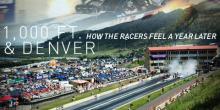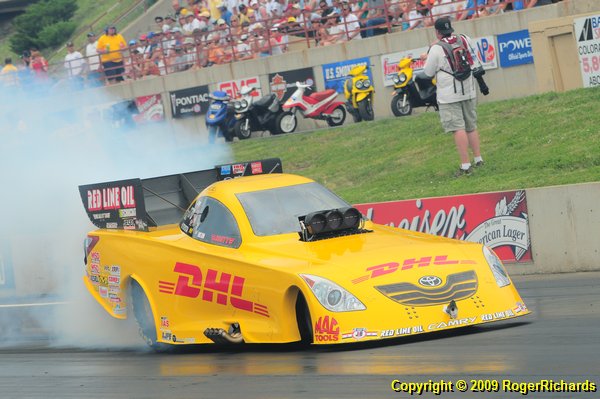DENVER, 1000-FT., A YEAR LATER

That event, however, is one of the most memorable of all time.
For the first time, the National Hot Rod Association had both the Top Fuel Dragster and Top Fuel Funny Cars race to 1000-feet, instead of the traditional quarter-mile (1,320 feet).
The two classes having been racing to 1,000 feet ever since.
NHRA's actions were brought about as a result of the on-track death of Scott Kalitta, a two-time NHRA world champion on June 21. Many fans have probably already forgotten what happened during the 29th Mile-High Nationals at Bandimere

Speedway.
That event, however, is one of the most memorable of all time.
For the first time, the National Hot Rod Association had both the Top
Fuel Dragster and Top Fuel Funny Cars race to 1000-feet, instead of the
traditional quarter-mile (1,320 feet).
The two classes having been racing to 1,000 feet ever since.
NHRA's actions were brought about as a result of the on-track death of
Scott Kalitta, a two-time NHRA world champion on June 21.
Kalitta's Funny Car, traveling about 300 mph, burst into flames and
crashed at the end of the track during final qualifying for the Lucas
Oil SuperNationals Old Bridge Township Raceway Park in Englishtown,
N.J. Kalitta, 46, died a short time after being taken to the Old Bridge
Division of Raritan Bay Medical Center in Englishtown, N.J.
A year later, drivers are applauding NHRA's 1,000-foot decision.
"I like the 1,000 foot at the tracks that are shorter," said Jeff Arend,
who replaced Kalitta in the DHL Toyota Funny Car. "There are some
tracks like Pomona, Englishtown and Reading, at 1320, if you had an
engine explosion and the chutes didn’t deploy, you almost for certain
going off the end of the track. That’s really not fair. I wouldn’t mind
racing quarter-mile on some of the longer tracks. Nothing really good
happens in the last 320 feet and .7 of a second. That’s where you have
your tire problems; you drop cylinders and hurt blocks. As a driver you
can still hear them revving up at that point, and they would get on the
rev-limiter and become hard to drive. I like it [1,000] because it
brings the driver and his reaction times into play. There’s not a lot
of room for the other guy to go around you.”
Bob Tasca III, who pilots the Motorcraft Quick Lane Ford Top Fuel Funny Car, concurred with Arend.
"As far as I am concerned, we don’t ever need to return to the
quarter-mile,” Tasca said. “The cars are bombs and how do you slow them
when an A/Fuel Dragster runs 280 miles per hour with no blower on it.
How do you slow down these cars with a blower on it the size of a small
child. To me, in racing 1,000 feet, we’ve never had it more
competitive. We have a better show."
Prior to Kalitta's death, Eric Medlen died while testing in March of 2007 at Gainesville.
Robert Hight, who was Medlen's teammate at John Force Racing, praised NHRA for changing the race distance.
“It’s unbelievable. You look at what Bandimere has done here and it’s
incredible," said Hight, who upset his team owner John Force in the
first round. I think its kinda the way it needs to be. Some of these
race tracks are too short. There are two options … let us race to 1,000
feet or slow us down. You’re seeing lots of good side-by-side racing in
1,000 feet.”
Arend believes the two most significant safety contributions has been
the automatic chute deployment and the fuel and ignition kill switch in
case of an explosion. The second is the catch fences and the sand
traps.
“That’s going to save a lot of people in the future, guaranteed,” Arend
said. “You won’t be going nearly as fast when you do go off of the end
of the track. We saw two people going into the net at E-town; Alexis
DeJoria was flying when she went into it and she came out okay. She was
out doing an interview five minutes later. I can’t help but think that
what happened to Scott and what they have done in the shutdown area,
has save lives and more will be saved in the future.”
Actually, Tasca thinks NHRA can do even more when it comes to safety.
“I still think there are things they can do to the motors to fix it,"
Tasca said. "That gets back to fuel volume. I think 1,000 foot was the
right decision. I bet you if you ask 100 fans you wouldn’t find any
that wouldn’t come back because it’s 1,000 foot. Norwalk to the
quarter-mile wouldn’t have been a show. Cars couldn’t hook up going to
1,000 feet. I think the fans have accepted it and the stands look full
to me. You’ll always have your traditionalists. But it has helped our
budgets, it’s flat out safer as a driver when you can hit the gas and
see the finish line.”
Advertisement


